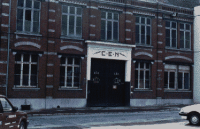Constructions Électriques du Nord
Northern Electrical Constructions (French: Constructions Électriques du Nord; abbreviated CEN), was a manufacturer of electrical machinery such as motors, generators, and outdoor warning sirens founded in 1897. CEN was one of the earliest manufacturers of sirens in France, producing them at least since 1926, and even after the company's closure, their sirens are a common sight in France.
History
Constructions Électriques du Nord was founded at the turn of the 19th century in 1897, with 1 source suggesting they were founded even earlier in 1885[1]. CEN started as little more than a small electrical machine shop, producing small motors which would power formerly steam-driven wool mills. The company's operations grew in size and scope during the 1900s, and the outbreak of World War I likely saw an increase in CEN's manufacturing capabilities.
Contrary to what some believe, CEN did not produce air raid sirens during World War I, with the only known manufacturers of sirens at the time being CICCA and Chollet, of which very little are known about. CEN's sirens came at a much later date in 1926, when the company began to produce various models of outdoor warning sirens under François Odoux's direction, the CEO of the company at the time. CEN produced sirens from then until its closure, with units hailing from the 1980s to support this claim. Production of CEN's sirens during the 1940s likely continued to increase during World War II, with high demand for sirens to warn the public of Axis air raids.
After the war, Odoux saw an opportunity to improve the primitive state of individual controls for small machines, with many at the time still controlled by pulley devices and belt transmissions. He founded FOX Motors in 1949, which complemented CEN's manufacturing and focused on fractional horsepower motors. FOX Motors began to produce sirens of their own in 1964, named the MONICA and PAKITA. The latter became predominant in the market, and competed with CEN's own NP2S and NP3S, despite Odoux's intention with FOX Motors to not compete with CEN at all. CEN began to produce brand new brushless AC motors begun in the early 1970s, as well as waterproof motors specifically built for a "UNITEC"'s water pumps, who later licensed their design to the American firm WEMCO.
Unfortunately, CEN had closed up shop by 1986, and became KM Europ, who carried over CEN's designs and model naming scheme. KM Europ as an independent company now no longer exists; it was later acquired by Finescur in 2006, who still produces CEN's sirens under the KMsecur name, and was split with Moflash in 2018, although Moflash's portion of KM Europ does not produce outdoor warning sirens. Though little is known about CEN, they were one of the most influential siren manufacturers in France during the 20th century; despite the company being long gone, CEN sirens are one of, if not the most common sirens in France's nationwide siren system. Today, FOX Motors continues CEN's legacy with their still manufactured PAKITA series of sirens, derived from CEN's models.
Products
NPx/NPxS series
The "NPx" or "NPxS" series consists of 5 known siren models : the NP00S, NP00S1, NP0S, NP1S, NP2, NP2S, NP3S and NP4S. The difference between the units with the S and the ones without are unknown, units with a 1 on the back are single phase, but only one single phase unit is known to exist (it being a NP00S1). There is ongoing speculation that the "S" might stand for "Standard".
NP00S(1) - NP1S
Often referred to as "pancake sirens", these are CEN's three smallest sirens, which were meant for small towns and mostly factories, and are their only known 12 port sirens. All of these sirens share the same design, while all being slightly different. They all have a trailing "S" despite the inability to attach horns.
Per the KMSecur brochure[2], the effective range of the NP00S/S1 is 500 meters (70db at 10m), the NP0S' range is approximately 800m (~85db at 10m) and finally the NP1S' effective range is 1 kilometers (95db at 10m). Those 3 sirens all peak at 570Hz.
NP00S(1)
The NP00S(1) is CEN's smallest siren. It consists of an 12 port rotor and stator. The motor on this siren varies depending on the version as it was offered in both single and three phase (NP00S and NP00S1), but both motors do share a similarity which is that both of them are TEFC. These sirens seem to be very rare, and less than 5 are known to exist. The NP00(S)(1) is supported by 3 trapezoid legs on the bottom. Not much information is known about them, but KMsecur still produces these as the "KM0", albeit slightly different. At least one of these sirens is in private possession by an enthusiast, and thus more information may appear about them at any point.
NP0S
The NP0S is a slightly bigger (or more powerful) NP00S(1) with almost no differences (except the motor). It consists of an 12 port rotor and stator. Unlike the NP00S(1), the NP0S' motor is not TEFC, and no single phase units are known to exist. These sirens seem to be the most common out of the "pancake" sirens, but once again, less than 5 are known to exist. The NP00S is supported by 3 trapezoid legs on the bottom. Not much information is known about them, but KMsecur still produces these as the "KM0S", with slight differences (with the KM0S notably having a TEFC motor).
NP1S
The NP1S is a slightly bigger (or more powerful) NP0S with almost no differences (except the motor). It consists of an 12 port rotor and stator. Unlike the NP0(S), the NP1S' motor is TEFC, just like the NP00S(1), and no single phase units are known to exist. These sirens seem to be the rarest out of the "pancake" sirens, with less than 3 known to exist. The NP1S is supported by 3 trapezoid legs on the bottom. Not much information is known about them, but KMsecur still produces these as the "KM1S", albeit with some slight differences.
NP2/NP2S and beyond
These are CEN's bestseller sirens, which found their way all across France. These sirens look basically the same but are slightly different.
NP2/NP2S
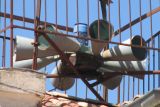
The NP2S (or sometimes NP2) consists of an 8-port rotor and stator. 8 conical horns are attached to each stator port, which likely improves the sirens' audible range. Some units have horns with mesh screens installed to prevent debris from entering, while others do not; whether this is because they never came with them, or the mesh screens have fallen off or degraded is unknown. The horns are offset with the angle of the ports, which is typical for most French sirens produced post-WWII. For clarity's sake, it is assumed that all the NP2 units have a trailing S unless otherwise specified.
The Type NP2S was also available without horns, leaving only the horn connecting pieces attached to the stator and mesh screens covering the openings. The NP2[S] is driven by a 50/60 Hz 2.2 kW (3 hp) 3 ph 230/400 V motor above the stator, which spins the rotor at around 2850 rpm. It is unknown if single phase units were ever offered, but that was likely the case. The motors used on the NP2[S] are taller and fan cooled ("Totally enclosed, fan-cooled" type), unlike the Type NP3S's which is shorter and lacks a fan; this is currently the only way to differentiate the two models apart, aside from looking at the tags bolted to the motor.
A cylindrical assembly with a mesh screen wrapped around it serves as the siren's intake and base. This design was later carried over to KM Europ after CEN went defunct, who seemingly only branded the siren and made no other changes. CEN and KM Europ-era units are relatively identical, and the same can be said for units produced once KM Europ became KMsécur. Despite the difference between the 2 sirens being relatively minimal, the NP2[S] was not nearly as successful as the NP3S; comparatively less NP2Ses units exist compared to NP3Ses.
The NP2S came in two variants, the "NP2" (no trailing S) which lacks the horn mounting points, curiously, the only known non-S NP2 siren is not branded by CEN but instead by Pallet services, and has a Leroy Sommer junction box.
The effective range of the NP2S is approximately 2,5 kilometers with horns fitted, without the horns, the range falls at around ~2 kilometers. Total output clocks in at around 114db at 10 meters in both cases[2].
NP3S
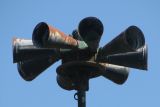
A slightly more powerful (4kW versus the 2,2kW of the NP2S) version the NP3S also exists, it is otherwise identical to the NP2[S] albeit it has a different motor that is shorter and lacks a cooling fan. Sound-wise, the NP3S has a very strong bass-y undertone with a faint raspiness, versus the NP2S' characteristic 50Hz rasp (when correctly wired). It also has been used as the base for the "Mark 2" gearbox sirens. It is not known if the NP3S and NP2[S] share the same rotor vane design (smooth, conical rotor on the NP3S) or not. Regardless, as far as those two models are concerned, they seem to be 99.99% identical. It is rumored that some NP3S units were fitted with a coding brake, although this is not confirmed.

The NP3S was also available without horns, leaving only the horn connecting pieces attached to the stator and mesh screens covering the openings. The NP3S is driven by a 50/60 Hz motor above the stator (with exact details unknown), which spins the rotor at around 2850 rpm. No known single-phase unit exists. The motors fitted on the older NP3Ses is shorter and lack a fan, unlike the NP2[S] which is taller and fan cooled; this is currently the only way to differentiate these sirens, aside from looking at the tags bolted to the siren, curiously enough, on the NP2[S] the tag is on the motor itself, but on the NP3S it is on the stator baffle.
Just like the NP2[S], this design was later carried over to KM Europ after CEN went defunct, who seemingly only rebranded the siren and made no other changes. CEN and KM Europ-era units are relatively identical, and the same can be said for units produced once KM Europ became KMséscur. Despite the difference between the 2 sirens being relatively minimal, the NP3S was the more successful of the two, with a majority of CEN sirens being Type NP3Ses. The KMsécur/KM Europ units all have a TEFC[3] motor regardless of being a KM2S or KM3S.
According to a document[2] found on KMsecur's website, the number in the KMxS-series represents the distance the sound of the siren will travel, (e.g 2km without horns and 2.5km with horns for the KM02S, 3km without horns and 3.5km with horns for the KM3S).
The NP3S' effective range with horns is approximately 3,5km and 3 kilometers without. It's total output is around 119db measured at 10m.[2]
NP4S
An even more powerful (9kW versus the NP3S' 4kW) and heavier variant (95 kilograms without horns, 127 kilograms with horns, making it one of CEN's heaviest sirens just behind the Mark 1 gearbox sirens and Mark 2 gearbox (NGx-series) sirens) of the NP3S is rumored to exist, however, no known units are known to exist, and there is one unit that is rumored to exist, but thus far it is not confirmed. The NP4S would have a 9kW motor and have an approximate effective range of 4 kilometers without horns, and outputs approximately 124dB at 10 meters. Currently, it seems that KMEurop still offer parts for this unit, it is not clear if the NP4S has been made or if it was only made on custom order.
"Mark 1" Gearbox sirens
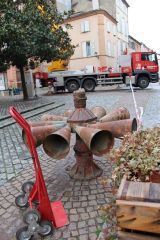
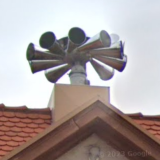
CEN produced several other models of sirens, none of which have known model names. These all share similar designs, with several unique aspects and variants. An example of these would be their "Gearbox" (the name is conjectural, as their exact model number is still unknown, they were often erroneously called double motor[5]/double speed sirens both nicknames coined by enthusiasts), which came standard in 8-port or 10-port, with conical horns are attached to each stator port. Some units have horns with mesh screens installed to prevent debris from entering, while others do not; whether this is because they never came with them, or the mesh screens have fallen off or degraded is unknown. The horns are offset with the angle of the ports, which is typical for most French sirens produced post-WWII.
These sirens came standard with a gearbox to speed the motors up. As expected, the rotors of these spin quite fast, at around 4400 (for the finned motor Mk.1 units) and 3750 (for the smooth motor ones) rpm. This is about twice as fast as most standard French sirens, thus the "double motor"/double speed" name. Both are relatively identical, with the only differences being variations in the motors used. At least 1 of these sirens was also equipped with some sort of damper mechanism. With a few exceptions, most of these sirens had their motors below the stator as opposed to on top of it like the Type NP sirens, with units with their motors on the bottom having a large conical shroud of varying size and shape suspended above the stator shielding the siren from the elements. It is unknown when exactly these were produced, and few of them exist, although they seem to be very common in Alsace and Oise.
There are two major variations known, the older "motor on bottom" ones are dubbed "Mark 1" or "Mk.1" and can be divided into multiple sub-categories:
- Mark 1 "Smooth motor" (10 ports), these are by far most common and the oldest of all Mark 1 units, they could optionally be fitted with a coding "sleeve" (though this was a rare option: only one was confirmed to have been equipped with it, another siren is suspected to be coded, but it has not yet been confirmed) they have a rather smooth sound owing to them spinning at around 3750 RPM. At least two versions of this model seem to have existed, earlier smooth motor units have a tall motor while later smooth motor units have a shorter and stockier motor (a perfect example of one such unit was formerly located in Moissac).
- Mark 1 "Finned motor" (10 and 8 ports), those are relatively late models, came in both 10 and 8 ports configurations. The 10 ports units spin at approximately 4400 RPM and have a higher pitched sound. It is suspected that those might be the so-called "Moteurs Fox MONICA" sirens, although this is unlikely to be the case. Those sometimes make a loud "clunking" noise like the later 10 port Mk2 units.
- Mark 1 "Finned motor 8-port", those could either come with the older finned-type motor as found on their 10-port counterparts or a short gearbox and different motor (as found on the "Mark 2" 8 port models), the short gearbox units are by far the rarest, and also the last Mark 1 units that CEN produced before switching to the "Mark 2" type.
"Mark 2" Gearbox sirens (NGx series)

Those sirens are the successor to the older "Mark 1" Gearbox sirens, they came in the following configurations:
- 8 ports, those are identical to the NP3S, but with a short gearbox added between the rotor and motor, those seem to be relatively common as far as Mk.2 units are concerned. Mk2 8-port units all seem to have a characteristic "clunk" noise when spinning up.
- 10 ports, those use a NP3S/NP2S-style rotor/stator assembly but with 10 ports instead of 8, there are a few sub-variants known to exist, with the most common version being equipped with the tall gearbox as used on the later "finned motor 10-port" Mark 1 units and either a NP3S-style motor or a TEFC[3] motor as found on the NP2S on later units (the TEFC units being slightly more rare). Curiously enough, those don't have the same clunk as their 8 port counterparts. It is suspected that the 10 port units bear the model number "NG12", according to a brochure found online[6] however, this is purely conjectural as to date, no known pictures of the ID tag of a NG12S has ever surfaced.
- "Deep tone" 8-port, this extremely rare version (only ~5-6 are known to exist in France, with 3 having been installed near Toulouse and one known active in Cernay, Alsace, the last one sits in an unknown location) instead of a gearbox, they are equipped with a gear reducer (which is considerably shorter in height than the gearboxes) and a larger TEFC[3] motor, as a side effect, they are considerably quieter than other models while having a very fast, near-instantaneous wind up. This model by far seems to either have been quickly discontinued or was only built on custom order. Its model number is not yet known.
- Known model numbers for the gearbox Mk.2 sirens is NG12, NG23, NG34, NG45, however, it is not known how the NG23 through 34 look like, and the NG12 is suspected (as stated above) to be the model number of the "10 port" Mk2 siren, only information available about the NG23-NG45 is their frequency, effective range (with or without horns) and their note.[6]
The NG-series sirens were briefly offered by KMEurop under the KMGxS range, it is not known when those were discontinued[7]
Direct drive (pre-NP/NG) series
At one point in its history, CEN made a series of "direct drive" sirens (again, name still conjectural), not much is known about those other than they came in two versions, 10 ports and 8 ports. The 10 ports variant (refered to as DD10 by the community) could come with horns, this was a rare option, only one or two units are known to have horns (one with short, possibly aftermarket, horns, and the other with longer horns), while there are many DD10s without horns. It is speculated that the DD10 is just a "tall smooth motor Mk1" gearbox siren minus the gearbox. No tag pictures are known to exist. The DD10s are somewhat easier to find compared to their 8 port counterparts, however they still remain relatively rare compared to the Mk1 gearbox sirens. To date, no DD10 sirens were filmed or are known to be active.
The 8 port version always came with with a short finned motor, two units (one in Pignans, Var, another one in Cinqueux, Oise) are known to have horns while an hornless unit is known to exist in Le Mesnil-Théribus, Oise. It isn't known how many "DD8" sirens remain.
Both direct drive CEN sirens are rare, if not rarer than their Gearbox cousins, it is also heavily suspected that the DD 8 units were actually made by Moteurs Fox under the Pakita brand name, the 8 port units all have a badge on the base, however, there is no pictures where the markings of the badge can be seen. The NPxS range has superseded the DD 8 units, while the DD10 did not get a direct replacement. Thus it seems that the "pancake" sirens (NP00S/1 through NP1S) are the spiritual successor of the DD 10 range.
References
- ↑ http://pgosse.chez.com/CEN.htm (in French)
- ↑ Jump up to: 2.0 2.1 2.2 2.3 https://www.kmsecur.com/wp-content/uploads/2018/11/Texte-KMxS.pdf
- ↑ Jump up to: 3.0 3.1 3.2 Totally Enclosed, Fan-cooled
- ↑ https://www.moissac.fr/actualites/cadre-de-vie/sirenes-dalerte-mardi-14-fevrier/
- ↑ This name is slightly misleading; these sirens do not have 2 motors, but instead utilize the pre-existing motor as well as a gearbox.
- ↑ Jump up to: 6.0 6.1 https://www.hellopro.fr/documentation/doc_produit/1436782_a90002c09ebecff68888198a2b722547_2510539.pdf page 11
- ↑ https://www.moflash.co.uk/wp-content/uploads/Documents/Catalogue/Km%20Catalogue.pdf page 98
